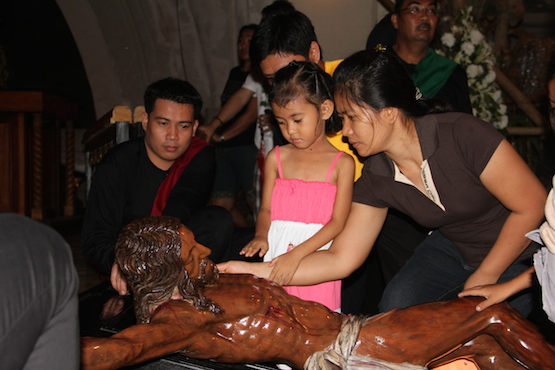Traditions keep Holy Week alive in the Philippines
In the Philippines, people say the rich inherit wealth while the poor inherit tradition.
Mar 21, 2016

MANILA: In the Philippines, people say the rich inherit wealth while the poor inherit tradition.
Last Saturday before Palm Sunday, Luzviminda Bueno sat on a sidewalk with her husband and daughter weaving fronds to sell the next day.
The Bueno family comes down from the province of Laguna to sell fronds outside a Dominican church in Quezon City every year.
The tradition was started four decades ago by Luzviminda's mother-in-law on the same spot outside the church.
"It's like a requirement for the family to do this every year," says Luzviminda. "It's a vow that must be followed religiously," she says.
Luzviminda's mother-in-law died 12 years ago in a car accident. A week before she died, she brought Luzviminda to the church to teach her how to weave fronds.
"It was as if she knew what was going to happen, and it was her way of passing on to us our inheritance," Luzviminda says.
"She loved me like her own daughter," she says. "By honoring the tradition, I feel like I honor her," she adds.
Lujelyn, Luzviminda's 17-year old daughter, has also vowed to keep the tradition going.
Palm Sundays have become a special day for the young girl for reasons more than it being a day to mark Jesus' entry into Jerusalem.
"I enjoy coming to the city to spend time with my family," Lujelyn says. "It never feels like work because I grew up helping my mother."
Tradition augments family income
While the others weave, Luzviminda's sister-in-law, Flora Desuyo, sells the palm fronds to augment the family income.
Flora and her husband, Maximo, struggle to keep their two daughters in school with their income from gardening and carpentry.
"The money we bring home is not enough to make ends meet," Flora says.
During the Holy Week, however, Flora earns about US$100 selling fronds.
"It might be a small amount but it helps a lot to address our needs," Flora says. "Life in the province is not easy," she says. "There are no jobs, and there are no opportunities to survive."
Aside from the financial reason, Flora says the family does not forget the meaning of Holy Week.
"We treat our days of labor as a form of offering to the Lord," she says. "It's our way of penitence."
Religious rituals
Holy Week is the time of year when Filipinos troop to the provinces for a long vacation.
The week kicks off bright and early on Palm Sunday morning when Catholics carry palm fronds to be blessed by the priest.
The fronds are later taken home and placed on front doors or windows supposedly to ward off evil spirits.
For many Filipinos, the Easter exodus starts straight after the blessing of fronds. Many take extra time off work to enjoy a weeklong vacation.
Holy or Maundy Thursday and Good Friday are national holidays, but many companies also give employees Wednesday off.
Maundy Thursday starts the Triduum, when Catholics observe the last Mass before Easter or the Institution of the Lord's Supper. Priests also renew their sacerdotal vows in an elaborate ceremony that attracts thousands.
The washing of the feet of the apostles is reenacted in many churches, followed by the procession of the Blessed Sacrament to the "Altar of Repose."
The traditional Visita Iglesia or church visit starts after Maundy Thursday rituals. People visit at least seven churches around town, supposedly to meditate on the Way of the Cross.
The trip is also a good excuse for families to go sightseeing.
Because the Blessed Sacrament is exposed on the Altar of Repose, many people stay out all night, some praying inside churches, many outside, enjoying the summer breeze in their town square.
Good Friday observance is usually observed with the Way of the Cross, the Siete Palabras or Seven Last Words, delivered by the best and most eloquent speakers, including politicians, actors, and priests.
A passion play called the Senakulo is staged in the afternoon, followed by a procession of devotees and flagellants who sometimes have themselves nailed on crosses, supposedly as expressions of penance.
Preparing for Easter
A weeklong, round-the-clock, chanting marathon of the narrative of Jesus' life, passion, death, and resurrection ends on Good Friday. In the evening, a funeral procession involving the image of the dead Christ is held.
Holy Saturday is known as "Black Saturday" or Sabado de Gloria. Jesus is dead so people celebrate. An early evening Mass is held for the Easter Vigil.
Easter Sunday usually starts with the traditional dawn salubong or meeting of the resurrected Jesus and his mother. Life-size statues of the Resurrected Christ and the Virgin Mary are brought in separate processions to come together at a designated area, usually in front of a church.
For this procession, the Virgin Mary usually has a black veil that is lifted by an "angel" suspended in midair above the images.
When the face of the Virgin is revealed, signifying the end of her grief, the angel sings the Regina Coeli in Latin. Church bells peal while the crowd erupts in joyous celebration.
In some parishes an image of Judas is hanged nearby and burned after the salubong, to signify the apostle's betrayal of Jesus.
From there the celebration continues, with singing, dancing and picnics. It's a fine way for fun-loving, faithful Filipinos to cleanse their souls.--ucannews.com







Total Comments:0